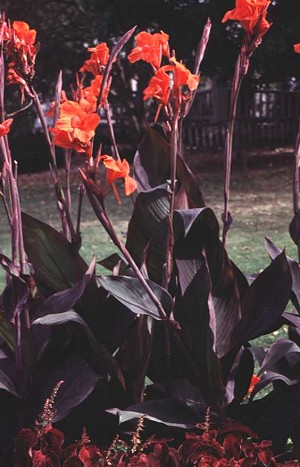
|
|
Cultivated
Canna (Canna X generalis)
|
Canna (Indian
Shot)
This
group (cannas) consists of sixty deciduous, rhizomatous, and tropical perennials, which
are mostly native to the moist, upland forests of Asia and Latin America. Two,
aquatic varieties, C. flaccida and C. glauca, are natives of Southern swamps.
These plants are valued for their gorgeous, colorful foliage and attractive,
Gladiolus-like flowers.
Cannas, or canna lilies,
look like banana trees without the trunk! Thatís no accident - theyíre kin
to bananas and gingers,
and their wide, furled leaves come out of thick, multiple-eyed rhizomes, just
like their larger, edible cousins. Flowers are the main reason cannas are so
highly prized, though. The tropical Indian shot (Canna indica) was hybridized and backcrossed with other
Canna species, including the North American native, golden canna
(C.
flaccida).
Indian shot is a robust perennial herb
up to three feet (1 m) tall that grows from a thick, branching, underground
rhizome. The large green leaves taper into slender petioles that form a sheath
around the main stem. Unlike the numerous cultivated varieties of domesticated
cannas (Canna x generalis), with showy yellow, orange, pink or red blossoms, the flowers of
C.
indica are much smaller and typically only come in red. Cannas are popular
cultivated flowers in tropical and temperate gardens because they produce some
of the world's most beautiful and exotic blossoms. The unique flower has three
small greenish sepals (appearing like bracts), three green or colored petals,
and five (or fewer) very showy petaloid false-stamens called staminodia. The
large, colorful staminodia form the main showy part of the blossom that people
associate with petals. Very hard, BB-like seeds are produced in bumpy, papery
capsules after the blossoms have withered away. Because of their dense, woody
seed coat, the seeds need to be scarified and soaked in water prior to
germination.
The spherical black seeds of Indian shot are so hard and perfectly round that
they resemble oversized BB's or buckshot from a shotgun shell. In fact, they are
so dense that they readily sink in water. Under a hand lens the seeds are
minutely-pitted, like the surface of pocked metal. The seeds are called "Indian
shot" because of their superficial resemblance to lead shot ammunition of
the 18th and 19th centuries. Although there is no definitive
proof of this, the seeds may have been used in flintlock muskets when lead shot
wasn't available. Throughout tropical regions of the world the shiny black beads
are strung into earrings and necklaces, often as spacers between larger beads or
mixed with silver trinkets and gemstones. According to The Wealth of India (1973), the seeds are bored
for necklaces before ripening. In many hybrid
cannas in cultivation, the seeds are more oblong-shaped.
Cannas are edible
like their larger cousins. At least some parts of them. The large and much branched rootstocks are full of
edible starch. The younger parts may be finely chopped and then boiled or pulverized
into a meal. Mix in the young shoots of palm cabbage for flavoring.
Source:
http://waynesword.palomar.edu/pljune98.htm
http://www.floridata.com/ref/c/cann_xge.cfm
http://www.survivaliq.com/survival/edible-and-medicinal-plants- canna-lily.htm
